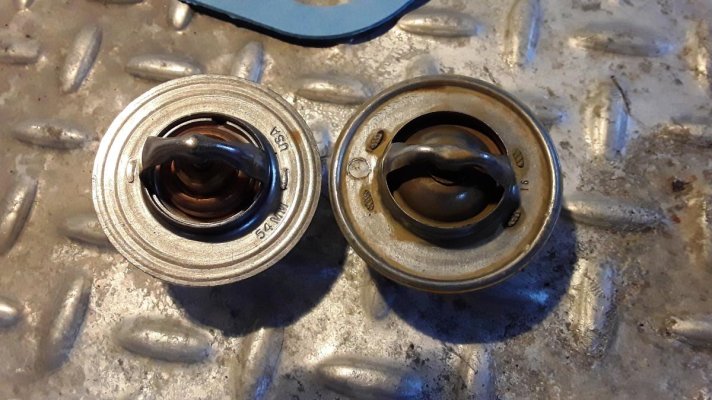Marco Flamingo
Guru
- Joined
- Jan 7, 2020
- Messages
- 1,177
- Location
- United States
- Vessel Name
- CHiTON
- Vessel Make
- Tung Hwa Clipper 30
A recent post went through some of the causes for the engine to not get up to temp. I had some of that problem with the engine only heating up to 170 if I was running the engine at 1800 rpm for some time. If I ran at 1650, it might get there towards the end of an eight hour run. The coolant can pass through the hot water heater and a Red Dot (bus heater), but even with those ball valves shut down it didn't get up to heat.
I bought a new thermostat (180 degree instead of 170) and installed it yesterday. I put my new one in water on the stove and used my IR thermometer to check the opening temp. First cracked open at 175 and kept opening a little after 180. When I pulled out the old one, I did the same thing. The old one first cracked open at 168 and fully open at 175.
When putting the old and the new side by side, I finally noticed what the problem was with the old one.

The old one on the right has a hole drilled in it. It is drilled, not punched, so I think that this is an "aftermarket" modification. Why would somebody want the engine to only heat to 130 for the first several hours? Even when cruising, if I slowed to 1500 the temp would drop. Anyway, issue solved.
I bought a new thermostat (180 degree instead of 170) and installed it yesterday. I put my new one in water on the stove and used my IR thermometer to check the opening temp. First cracked open at 175 and kept opening a little after 180. When I pulled out the old one, I did the same thing. The old one first cracked open at 168 and fully open at 175.
When putting the old and the new side by side, I finally noticed what the problem was with the old one.

The old one on the right has a hole drilled in it. It is drilled, not punched, so I think that this is an "aftermarket" modification. Why would somebody want the engine to only heat to 130 for the first several hours? Even when cruising, if I slowed to 1500 the temp would drop. Anyway, issue solved.

